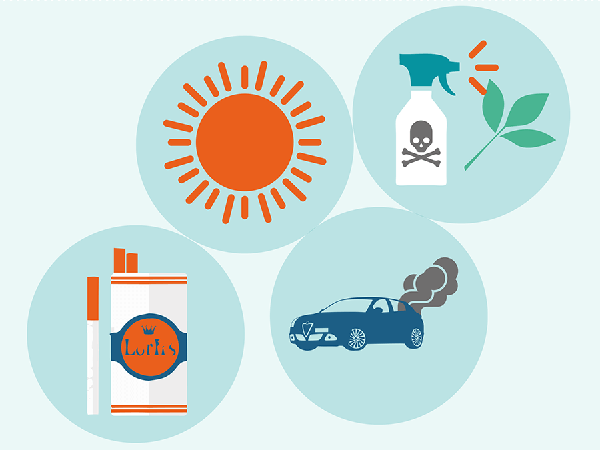Charting a Course toward Precision Cancer Prevention
, by Stephen J. Chanock, M.D.
Today, in JAMA Oncology, with my colleagues in the Division of Cancer Epidemiology and Genetics and elsewhere, we published a study on a risk prediction model developed to assess the absolute risk of breast cancer in women of European background in the United States.
The model takes into effect risk factors that can be modified, like alcohol use, and those that can’t, like family history and the constellation of previously identified common genetic risk variants, or SNPs. This multifaceted model can more precisely identify the subsets of women at highest risk of breast cancer who would be most likely to benefit from alterations to those modifiable factors.
The extent to which this model can be used to influence the behavior of individual women at increased breast cancer risk requires further study, of course. But it raises an important issue that cancer researchers are increasingly beginning to explore. Instead of studies that focus on what proportion of cancers are due to genetic differences, we now understand that it might be more insightful to inquire how the risk of each type of cancer is influenced by genetic predisposition to both the cancer and the effects of environmental exposures.
By this, I mean we must push research to uncover the more complex nature of cancer’s causes—and means of prevention—using the combination of environmental exposure observations and genetics. The two are in constant struggle and, thus, it makes sense to more closely study how and in what way our genetic origins influence how and in what way we respond to distinct environmental challenges.
Advances from genomic technologies—specifically, examinations of germline DNA—have accelerated the discovery of regions of the human genome associated with cancer risk. The risk can be minimal, as with common alterations identified through genome-wide association studies (GWAS), or substantial, as with rare mutations such as those in the BRCA1 gene that often run in families. The latter has been studied primarily in families over many decades, whereas recently, larger population studies have been the source for GWAS, which have netted more than 500 chromosomal regions that contribute to risk, each in small ways.
Each of the common risk variants revealed through GWAS points to an interesting story as to how and why cancer could evolve, but it is with large data sets that we can now test the value of polygenic risk scores (i.e., the combination of many small effects) to stratify individuals based on risk. This, in turn, could be useful for more judicious allocation of either screening or preventive measures.
Consider that it could be plausible to stratify individuals based on their polygenic risk score. For example, a polygenic risk score for breast cancer could be used to identify women at higher risk, who could benefit from more aggressive measures to alter modifiable factors (such as holding down one’s weight, eliminating tobacco, and limiting alcohol use) for those at highest risk.
Since 2007, the fruits of annotating variation across the genome have begun to pay major dividends in the form of discoveries that may have possible clinical or public health utility. We are still relatively early in our work to understand how variation in the genome—places where a stretch of DNA could vary from one person to the next, sometimes by as little as a single base pair —affect a person’s risk of disease.
The falling costs of technologies that test specific sites of genomic variation or that enable sequencing of exomes and whole genomes have generated data on an unprecedented scale. Based on data from large collaborative projects, we have begun to define the underlying genetic architecture of cancer risk by cancer type. Already, we have observed that different types of variation predispose individuals to common cancers, including those of the breast, prostate, and colon.
With these approaches and a growing body of genomic data, we are moving closer to being able to compile a comprehensive list of the genetic variants associated with cancer. This information —when combined with knowledge of the mechanisms by which these variants affect cancer risk, and the established environmental and lifestyle factors—will give us new insights into the biology of cancer and could ultimately lead to a tailored approach to reducing the risk of cancer. That is, precision prevention.
In this regard, health providers could use genomic profiles to identify patients who would be most likely to benefit from specific strategies for the prevention of certain cancer types. For instance, studies have suggested that individuals with certain genetic characteristics could reduce their risk of colorectal cancer by taking a low dose of aspirin every day, whereas individuals without these characteristics would be unlikely to experience the same risk reduction.
Building the Catalog of Genetic Susceptibility
For some common cancers, GWAS have revealed many common variants that, individually, have a small effect on overall cancer risk. DCEG carries out a robust research program to better understand how both common and rare genetic variants combine to affect susceptibility. But more research is still needed.
The common variants emerging from recent studies represent just part of the overall picture of cancer risk. But the growing body of evidence allows researchers to consider an important question: Can we use knowledge of the set of common genetic variants to identify individuals at higher or lower risk of certain cancers and who may or may not benefit from prevention strategies?
Currently, standard epidemiologic risk factors are used to assess the risk of some common cancers. But the risk categories (e.g., high or low) tend to be broad, and our confidence in the statistical accuracy for any one individual could be limited. Genetic information could potentially allow us to refine the risk categories and increase our confidence in risk assessments.
As this work moves forward, a challenge will be to describe the mechanisms by which genetic variants contribute to cancer initiation. For example, we have discovered that many variants associated with cancer risk reside in regions of the genome that do not code for proteins but could regulate gene activity. The fruits of the GWAS in cancer have pointed us towards investigation of how and in what small perturbations of the regulation of key signaling pathways could influence cancer risk. We are just beginning to layer environmental exposures on top of these regions to better understand how individuals could differ in their response to environmental stimuli.
Some researchers have begun to ask whether risk variants could also influence the progression of different types of cancer. The answers to this and other questions will be critical for advancing our understanding of the biology of cancer and potentially for developing new approaches for prevention, early detection, and treatment.
From Germline to Tumor Genetics
In parallel, there have been major strides in our understanding of the genomic changes characteristic of different cancers. The Cancer Genome Atlas (TCGA) has enabled the community to look for profiles of the tumors that could be important for new cancer classifications as well as the identification of shared mechanisms or mutations across cancers. That knowledge, in turn, could widen the opportunities for new and old drugs for treatment.
By studying variation in DNA within individual cancer patients—looking both at their germline and tumor genomes—we could learn additional clues about the evolution of genetic mutations that drive specific cancers. How and in what way germline variations inform our understanding of the somatic changes in tumors represents a set of opportunities to develop effective precision medicine strategies. At the same time, we could one day develop individual profiles that could be used to target high-risk portions of the population, particularly to reduce exposure to such carcinogens as tobacco use or poor eating and sleeping habits.
To explore these and other questions, collaboration among scientists, including epidemiologists, geneticists, and others, will be critical. With their continued work, we can build a catalog of genetic susceptibility and use that knowledge to explore potential clinical applications as we move closer toward the goal of precision cancer prevention.

